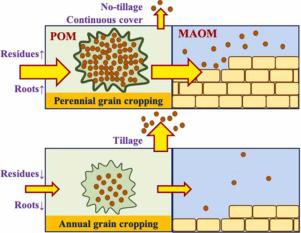Soil and Tillage Research ( IF 6.1 ) Pub Date : 2022-03-21 , DOI: 10.1016/j.still.2022.105376 Keunbae Kim 1 , Erin J. Daly 1 , Monika Gorzelak 2 , Guillermo Hernandez-Ramirez 1

|
Carbon sequestration in agricultural soils can play a pivotal role in the mitigation of accelerating climate change. Our research evaluated a continuum of agricultural cropping systems, including innovative perennial grain cropping, to assess which systems promote increases in and stabilization of soil organic matter (SOM). In comparison with conventional annual cropping systems, perennial grain cropping may be conducive to increased C accrual resulting from no-tillage management, longer growing seasons, and extensive root growth associated with these novel systems. Furthermore, the effects of N fertilizer addition on SOM dynamics under contrasting cropping systems were examined. We conducted physical SOM fractionation into particulate (POM) and mineral-associated organic matter (MAOM) in samples taken over two years from two experimental sites in Central Alberta, Canada. Five contrasting cropping systems (perennial-forage, perennial-grain, fall-grain, spring-grain and fallow) both with and without N fertilizer were tested. Our findings demonstrate that perennial-grain cropping was consistently superior in sequestering SOM-C compared to annual-grain crops at the surface soil layer (0–15 cm depth, Ps< 0.05). Over the duration of this experiment, perennial-grain cropping considerably boosted C accumulation in the recalcitrant SOM pools as represented by increasing MAOM, particularly at the Edmonton site, which is characterized by a clay-rich, Black Chernozemic soil (MAOM: 41.5 and 45.3 g C kg−1 in annual and perennial crops, respectively, P < 0.05). However, recurrent N fertilizer additions diminished C sequestration by perennial-grain cropping in both POM and MAOM fractions (Ps< 0.05). Correlation analysis indicated that accrual and allocation of C within the soil profile was more closely related to aboveground crop biomass productivity as opposed to root growth, particularly for generating more intermediate-labile POM. Our results shed light on how to achieve greater soil C sequestration as a function of cropping system options, N fertilizer addition and underlying soil texture.
中文翻译:

土壤有机质库对多年生粮食作物和氮肥的响应
农业土壤中的碳封存可以在减缓气候变化加速方面发挥关键作用。我们的研究评估了一系列农业种植系统,包括创新的多年生谷物种植,以评估哪些系统促进了土壤有机质 (SOM) 的增加和稳定。与传统的一年生种植系统相比,由于免耕管理、更长的生长季节以及与这些新系统相关的广泛的根系生长,多年生谷物种植可能有助于增加碳的积累。此外,研究了在对比种植系统下添加氮肥对 SOM 动态的影响。我们在两年内从加拿大艾伯塔省中部的两个实验地点采集的样品中,将 SOM 物理分馏为颗粒物 (POM) 和矿物相关有机物 (MAOM)。测试了使用和不使用氮肥的五种对比种植系统(多年生草料、多年生谷物、秋粮、春粮和休耕)。我们的研究结果表明,与表层土壤层(0-15 cm 深度,Ps < 0.05)。在本实验期间,多年生谷物种植显着增加了顽固的 SOM 池中的 C 积累,表现为 MAOM 增加,特别是在埃德蒙顿地点,该地点以富含粘土的黑色黑钙土为特征(MAOM:41.5 和 45.3 g C kg -1分别在一年生和多年生作物中,P < 0.05)。然而,在 POM 和 MAOM 部分中,经常性的 N 肥料添加减少了多年生谷物作物的 C 固存(Ps< 0.05)。相关性分析表明,与根系生长相比,土壤剖面内碳的积累和分配与地上作物生物量生产力更密切相关,特别是对于产生更多的中间不稳定 POM。我们的研究结果揭示了如何根据种植系统选择、氮肥添加和底层土壤质地实现更大的土壤固碳。










































 京公网安备 11010802027423号
京公网安备 11010802027423号